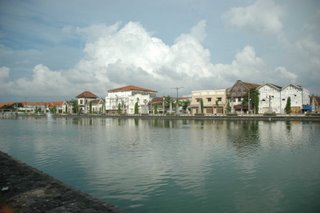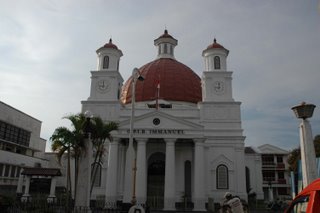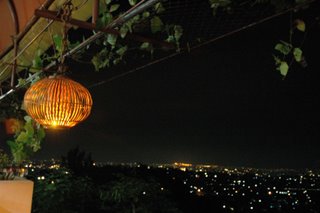Haloscan commenting and trackback have been added to this blog.
hometown, place where my heart belongs...
I would like to share some information on my hometown, Semarang, Central Java-Indonesia. I do hope that the information will be useful for anyone who would like to know more about my lovely hometown...
Wednesday, April 12, 2006
Monday, April 03, 2006
Semarang, my hometown
Welcome to my hometown, SEMARANG!
The city of Semarang, the capital of Central Java province is located on the north coast of Java Sea. The Northern part of the city is lying across on the plain coast and the Southern part is on the hilly side from Candi Baru area upward to the town of Ungaran.
Semarang is a busy administrative and trading city, most of the offices, business centers, industrial estates are concentrated in the low land, where as in the hilly side, there are many houses with the beautiful gardens with a superb view to the town and the sea.
The old records of this city date back to the 15th to the 18th century AD in where captivating ancient and colonial monuments still standing to present date.

ride the three wheeled "becak", stroll along the old town part of Semarang!

the old town part, the view from the train station
MEMORY OF THE OLD TIME
Around Candi, the upper part of the city, Bergota from Hindu era, the fortification of Prince Puger from MATARAM, the grave of Ki Ageng Pandan Arang and Kyai Saleh in Mugas street attract many pilgrims.In the west part of Semarang, a temple SAM POO KONG or locally known as Gedong Batu (Stone Building) was dedicated to Chinese Moslem Admiral Cheng Ho, his fleet arrived in the first time at 1406 AD The other Chinese Buddhist temple is Tay Kak Sie at Lombok Street built in the year 1772. (you can see the photo in "pretty places" link on this page).
GEREJA BLENDUK This is the eldest Christian Church in Central Java built by the Dutch community in 1753. It shows the Church architecture of the 18th century with its huge dome and a baroque organ inside the building. Nearby the Church, there are some buildings from the Dutch colonial time.

gereja Blendhuk
FOOD
Semarang is famous for its Lumpia (Chinese Spring Rolls), Pia, Wingko (sweet cakes made of rice flours), Bandeng Presto ( Tendered Fish ). All are yummy... You can also easily finding the sea food stalls everywhere in this nice warm city!

enjoy the foods at the food stall along the street
STASIUN TAWANG, the main railways station with its "Old Time" architecture located also in this area.
LAWANG SEWU, (Thousand Doors), In the downtown of Semarang is also a remarkable building from the "Old Dutch Time". You can even stroll down under the basement and find some surprising secrets of this building from deep under: the jails in the water...

Lawang Sewu

view of Semarang from Gombel in the night
GOMBEL, A favorite place on the hill with its fresh air and picturesque landscape. In the evening, people like to be here to relax while enjoying the panoramic vista to the city and the harbor.
THE NEW CITY
Today Semarang has few relics of an illustrious past, which shows the activities of business conducted by Dutch, Chinese and Javanese Moslem traders. The City is prospering, many new constructions rise, it is likely preparing to be a metropolitan town which keeps properly its precious memory of the by gone days. The busy street Jl. Pemuda in the downtown has some places of interest.

Tugu Muda, Semarang's landmark
TUGU MUDA (THE YOUTH MONUMENT) is a nostalgic remembrance for the heroic fight for independent and commemorated on October 14 and 15 every year.

Simpang Lima, the city square, and the tower of Baiturrahman mosque
SIMPANG LIMA, it is a square with many shops and cinemas around. In the evening a lot of people are here taking a walk or window-shopping. Early in the morning, people are jogging along the street.
BAITURRAHMAN MOSQUE, showing a mixture of old and new design. Other places worth to see among other are :
RONGGOWARSITO MUSEUM, it is a place displaying a systematical education of cultural historical development of earth and human life. A brief history of the country is also exposed. JAMU ( HERBAL MEDICINE ) MUSEUMS
Jamu or herbal medicime has always been used in this country since ancient period, it is very popular here, it is sold almost every where by different means, from JAMU GENDONG (jamu that is sold from kampong to kampong, carried on the back of a woman) to the special shops in modern malls. Just like modern western medicine, jamu has a large range of products to cure different diseases. More than that it has also specific products to keep a healthy life. Two Museums dedicated to jamu are :
Nyonya Meneer, on Jl. Raya Kali Gawe.
Jago, on Jl. Setia Budi No. 273.
THE INDONESIAN RECORD MUSEUM is also located at Semarang. It is in the some building with Jago Museum. It shows some pictures of special records in Central Java e.g: the tallest man/woman, the shortest, the fastest etc...
PURI MAERAKACA
It is a well arranged park on the beach exhibiting traditional houses of every central Java regencies. In these houses, specific crafts of each regency are displayed.
TINJOMOYO (NEARBY GOMBEL)A public entertainment place where different shows performed such Kethoprak (Traditional Theater with stories of Javanese Kingdoms period ), wayang, as well as band music. There are restaurants, and souvenir shops.
THE CITY ZOO
There are various local animals here.
THE ENTERTAINMENT
There are two famous groups of Wayang Orang (Wayang Theatre) belong to this city :
1. NGESTI PANDOWO
2. SRI WANITO, from these words, which mean queen of women, all players are women.
Recently these highly valued groups as many others cultural traditional groups are facing the decreasing of public's attention... The Ngesti Pandowo group sometimes performs at Taman Budaya Raden Saleh (TBRS) and Gedung Kebudayaan (Cultural Building).
WAYANG KULIT ( SHADOW PUPPET ) regularly performed twice every month in the town of Semarang.
1. On the 17th day of the month in The Governor's office.
2. Every Friday Kliwon in TBRS.
CULTURAL EVENTS
DUGDERAN FESTIVAL
Organized in front of grand mosque in Pasar JOHAR area marks the beginning of fasting month. The name Dug-der, came from the sound of the mosque drum and sound of firecrackers. There is a BAZAR for several days.
So, that's a little story about my city!
Sources:
www.joglosemar.co.id
www.kompas.co.id
personal photos
Wednesday, March 01, 2006
Indonesia, My Country

Jakarta by night
Whenever I'm travelling to strange country, there are always questions about Indonesia that sometimes shock me.
Wanna know the examples?
Here they are:
Do you have many cars in your country?
Do you have pinneaple in your country?
Do you eat avocado?
and the worst was,
Where is it?
I don't blame people for not learning enough in geography, but somehow I feel just sad to realize that when I was in school we learned so much about the other countries in the world. So, here are some informations about Indonesia that you might want to know:
Cars in my country?
See the picture above, and you'll see that it's not just about cars, but we also have the thing that is called "traffic jam".
In the case for pinneaple and avocado, I believe that you know that those exotic fruits just live in tropical weather. And, Indonesia is obviously crossed by the equator line.
Here are some informations I copied from the CIA world fact book...
Indonesia is the world's largest archipelagic state.
Geography
Location:
Southeastern Asia, archipelago between the Indian Ocean and the Pacific Ocean
Geographic coordinates:
5 00 S, 120 00 E
Map references:
South East Asia
Area:
total: 1,919,440 sq km land: 1,826,440 sq km water: 93,000 sq km
Area - comparative:
slightly less than three times the size of Texas
Land boundaries:
total: 2,830 km border countries: East Timor 228 km, Malaysia 1,782 km, Papua New Guinea 820 km
Coastline:
54,716 km
Maritime claims:
measured from claimed archipelagic straight baselines territorial sea: 12 nm exclusive economic zone: 200 nm
Climate:
tropical; hot, humid; more moderate in highlands
Terrain:
mostly coastal lowlands; larger islands have interior mountains
Elevation extremes:
lowest point: Indian Ocean 0 m highest point: Puncak Jaya 5,030 m
Natural resources:
petroleum, tin, natural gas, nickel, timber, bauxite, copper, fertile soils, coal, gold, silver
Land use:
arable land: 11.32% permanent crops: 7.23% other: 81.45% (2001)
Geography - note:
archipelago of 17,508 islands (6,000 inhabited); straddles equator; strategic location astride or along major sea lanes from Indian Ocean to Pacific Ocean
People
Population:
241,973,879 (July 2005 est.)
You can have some more ideas on Indonesia on my blog, just click on the link to beautiful places...and enjoy the beauty of Indonesia! =)
Saturday, June 11, 2005
Java History
The Javanese are mostly descended from migrants who settled the island in waves from about 4000 BC. Sawah - or wet rice - agriculture was developed gradually from 2000 BC, and trade with South India began as early as the 3rd century AD. It's believed that this contact led to the adoption of Hinduism in coastal kingdoms, while southeast Asian Buddhism was also an influence and developed side by side with Hinduism, along with older beliefs.
Wet rice agriculture led to the development of a village-based social system dependent on mutual cooperation, overlaid with a hierarchical court culture. In 732 AD the Hindu King Sanjaya founded the kingdom of Mataram, Java's first major political entity, which controlled much of central Java and built the Borobudur temple complex. By the 10th century, King Sendok's East Javanese kingdom was dominant; it was later extended by Airlangga and split into two, the eastern Janggara and the western Kediri, after his death.
Mongols invaded Java in 1292, bringing to the throne a new king, Wijaya, and a new kingdom, the Majapahit Empire, which would become the most powerful and famous of Javanese kingdoms until it fell in 1400, by which time Islam was making serious inroads, especially in coastal ports. One of these, Demak, rose to become the first great Javanese Islamic state.
Coinciding with Islam's rise was the arrival of the Portuguese in 1511, soon followed by the Spanish, British and Dutch. As the Europeans jousted for position, the last Hindu kingdom fell to Islam in 1580. A second Mataram Empire - Islamic, but featuring much of the old court tradition and Javanese philosophy - sprang into existence and reached its peak in the early 17th century, dominating much of the island.
In the course of the 17th century, the Dutch became increasingly militaristic. Though they never controlled the island, they learned how to play rivals off against one another as Mataram disintegrated through the 18th century. By the early 19th century the Dutch had extended their influence over the sultanates of the interior and claimed Java as Dutch territoy.
By the end of the Java War (1825-1850) Dutch control over the island was almost complete. The infamous 'Culture System' was introduced to make the colony profitable. It was essentially a system of forced labour and it generated great wealth for the Dutch. The Javanese aristocracy became figureheads and the peasantry were subject to famine and epidemics. Dutch public opinion led to reforms of the system, beginning in 1870: forced labour was replaced by a land grab. The Javanese elite was coopted into the colonial administration and Islam became the peasants' focus for opposition to exploitation.
At the turn of the 20th century, the Dutch instituted an Ethical Policy, making it the government's duty to further Indonesians' welfare. The Javanese economy declined as economic activity shifted to other islands. Education became more accessible but remained inadequate - Java's population growth was outstripping all welfare efforts. Moreover, it fuelled the rise of nationalism, of both the Islamic and communist variety. When the Japanese marched into Batavia in 1942 they were greeted as liberators, but the tide of opinion soon changed. Soekarno proclaimed independence when they left in 1945, but the Dutch returned and insisted nothing had changed, leading an armed struggle that lasted from 1945 until 1949 and involved the Dutch, the British, the United Nations and the often fractious Republican Army. Soekarno became independent Indonesia's first president on 27 December of that year.
The new nation was beset by problems - economic, ethnic and religious, and political - but Soekarno's PNI dominated the first parliament from 1955. In 1957, he declared martial law and an era of 'guided democracy'. The ensuing period to 1965 saw political power increasingly concentrated in Java; the army and the Communist Party grew in power, with Soekarno in the middle. When the president began courting the favours of Beijing, the army acted.
Beginning on 30 September 1965, factions of the army plotted coups and counter-coups in a battle of wits and brawn that eventually unleashed an anticommunist pogrom and saw General Soeharto gain the ascendancy. Soekarno remained president two more years, but the pro-Western Soeharto was effectively the boss and assumed the official title of president in 1967. Elections were held in 1971 but - though it enjoyed the support of the West - under his 30-year rule, Soeharto's regime of one-party crony capitalism was essentially anti-democratic in temperament. It was also - despite some impressive economic achievements - corrupt.
Soeharto was unable to assure a stable succession, so when the Asian currency crisis hit Indonesia in July 1997 - leaving the economy teetering on the edge of backruptcy - IMF reforms spelled the end of the cosy Soeharto family arrangements. Inflation prompted riots in Java, the ruppiah collapsed, and inflation and unemployment surged, leading in 1998 to the worst civil disturbances since the mid-sixties. Soeharto stepped down on 21 May of that year.
Despite his reform efforts, BJ Habibie's presidency was an unsettled one. Java continued to suffer reduced standards of living and widespread riots. Abdurrahman Wahid became Indonesia's first democratically elected president in June 1999. His style fused elements of Islamic holy man and Javanese mystic, but he was unable to pull together the disparate forces that threatened to tear the country asunder. Riding a wave of nostalgia for her father, Megawati Sukarnoputri replaced Wahid in July 2001 when he was impeached for collusion in two financial scandals.
Upon the rise to power of Megawati, Indonesia faced numerous crises - rising Islamic extremism, military insubordination, official corruption, a fledgling and fragile democratic process, and the many separatist movements threatening to tear the country apart. Throughout this period, Java remained the political power hub of one of the world's most numerous nations. Most of the nation's political elite and intelligentsia derived from the island, and the peculiarly Javanese mix of Islam and local belief dominated the national culture. Overcrowding and environmental degradation were the main problems facing Javanese, which is one reason why many volunteered for relocation to less populous islands.
Megawati Sukarnoputri's presidency restored stability and growth but was ineffectual in combating rampant institutional corruption. In September 2004, 80% of Indonesian voters turned up to vote in the country's first direct presidential ballot. Charismatic retired general – and sometime crooner - Susilo Bambang Yudhoyono (who holds an American management degree) won handsomely.
source : www.lonelyplanet.com

